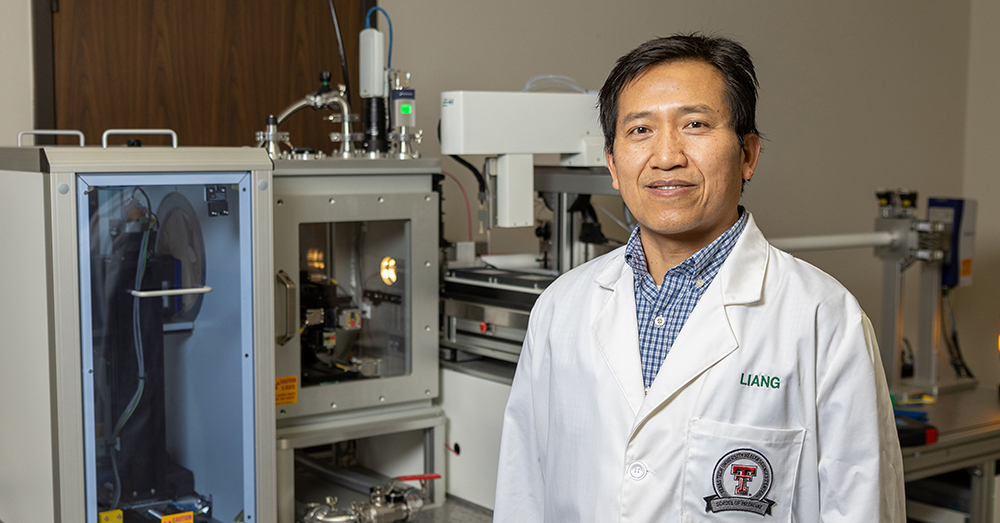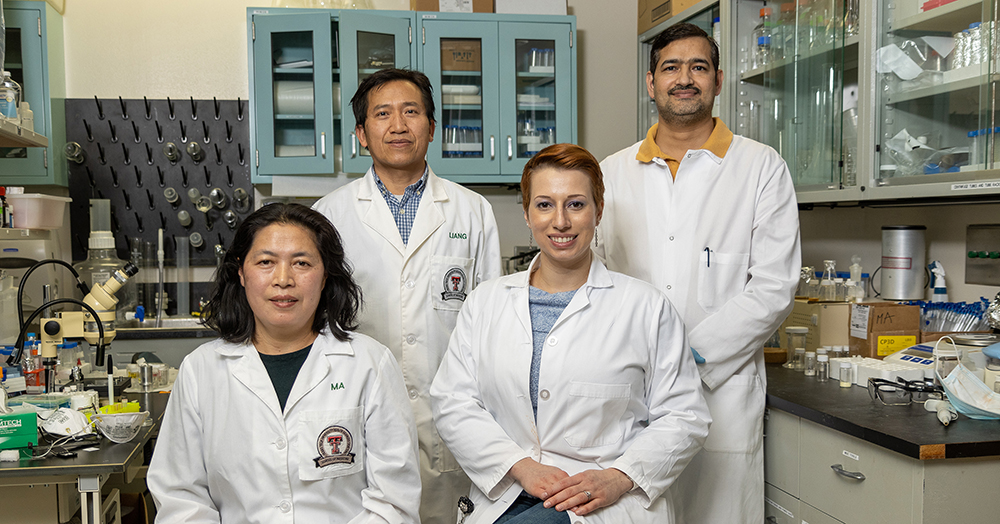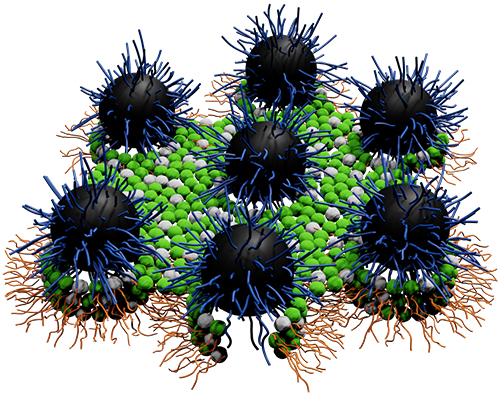TTUHSC Scientist Seeking Solution to Antibiotic Resistance
Novel Nanoantibiotics Kill Bacteria Without Harming Healthy Cells

The Centers for Disease Control and Prevention estimates that more than 2.8 million Americans experience antibiotic-resistant infections each year; more than 35,000 die from those infections.
To address this critical and worldwide public health issue, a team of researchers led by Hongjun (Henry) Liang, Ph.D., from the Texas Tech University Health Sciences Center (TTUHSC) Department of Cell Physiology and Molecular Biophysics, recently investigated whether or not a series of novel nanoparticles can kill some of the pathogens that lead to human infection without affecting healthy cells.
The study, “Hydrophilic Nanoparticles that Kill Bacteria while Sparing Mammalian Cells Reveal the Antibiotic Role of Nanostructures,” was published Jan. 11 by Nature Communications. Other study members of the Liang team, all from TTUHSC, included Yunjiang Jiang, Ph.D., Wan Zheng, Ph.D., Keith Tran, Elizabeth Kamilar, Jitender Bariwal, Ph.D., and Hairong Ma, Ph.D.
Past research has shown that hydrophobicity (a molecule’s ability to repel water) and hydrophilicity (a molecule’s ability to attract and dissolve in water) affects cells; the more hydrophobic a substance is, the more adverse the reaction it will cause. However, Liang said, there is no quantitative standard for how much hydrophobicity is acceptable.
“Basically, you can kill bacteria when you increase hydrophobicity,” Liang said. “But it will also kill healthy cells, and we don't want that.”

For their study, the Liang team used novel hydrophilic nanoparticles known as nanoantibiotics that were developed by Liang’s laboratory. Structurally speaking, these novel nanoantibiotics resemble tiny hairy spheres, each composed of many hydrophilic polymer brushes grafted onto silica nanoparticles of different sizes.
These synthetic compounds, which Liang’s lab produces, are designed to kill bacteria via membrane disruptions like antimicrobial peptides do, but through a different mode of membrane remodeling that damages bacterial membranes and not mammalian cells. Antimicrobial peptides are a diverse class of amphipathic molecules (partially hydrophilic-partially hydrophobic), which occur naturally and serve as the first line of defense for all multicellular organisms. The direct use of antimicrobial peptides as antibiotics is limited by their stability and toxicity.
There have been other studies in which researchers grafted amphipathic molecules onto nanoparticles, and they too kill bacteria. However, Liang said the primary issue in using amphipathic molecules is that it becomes very difficult to strike the right balance between their hydrophobicity and hydrophilicity so that the toxicity of these molecules to our own cells is significantly reduced.
“In our case, we remove that uncertainty from the equation because we started with a hydrophilic polymer,” Liang pointed out. “The cytotoxicity of hydrophobic moieties is not a concern anymore. Those hydrophilic polymers by themselves, or the silica nanoparticles alone don’t kill bacteria; they have to be grafted onto the nanostructure to be able to kill bacteria. And so, this is the first important discovery.”

Nanoantibiotics developed by the Liang lab are tiny “hairy” spheres comprised of polymer brushes (blue) covalently grafted atop silica nanoparticles (black). Once they land on bacterial membranes (headgroups in green and white; hydrocarbon tails in golden), the bundled polymer brushes act as daggers to pierce the bacterial membranes.
The Liang team also discovered that the degree of antibiotic activity is affected by the size of the hairy spheres, which according to Liang is the second important discovery of this research. Those measuring 50 nanometers and below appear to be much more active than those whose size exceeds 50 nanometers. Liang said those measuring approximately 10 nanometers appear to be the most active. (Using synchrotron small angle x-ray scattering and other methods, the Liang team is able to interpret the molecular mechanism of the size-dependent antibiotic activity.)
These discoveries are important because using nanoantibiotics to kill bacteria evades all known mechanisms of bacterial resistance unless bacteria completely revamp their pathways for making cell membranes, which Liang said is unlikely.
“It is also nearly impossible for bacteria to develop new resistance against the nanoantibiotics,” Liang emphasized. “Furthermore, this discovery illuminates a blueprint to develop new antibiotics that would kill bacteria upon contact, but remain amiable to humans because they are produced using non-toxic and environmentally friendly ingredients via nanoengineering.”
Related Stories
Celebrating Veterans: TTUHSC’s General Martin Clay’s Legacy of Service and Leadership
From his initial enlistment in the Army National Guard 36 years ago to his leadership in military and civilian health care management roles, Major General Martin Clay’s career has been shaped by adaptability, mission focus and service to others.
Texas Tech University Health Sciences Center School of Nursing Named Best Accelerated Bachelor of Science in Nursing Program in Texas
The TTUHSC School of Nursing Accelerated Bachelor of Science in Nursing (BSN) program has been ranked the No. 1 accelerated nursing program in Texas by RegisteredNursing.org.
TTUHSC Names New Regional Dean for the School of Nursing
Louise Rice, DNP, RN, has been named regional dean of the TTUHSC School of Nursing on the Amarillo campus.
Recent Stories
TTUHSC Cancer Researcher Honored by National Academy of Inventors
C. Patrick Reynolds, M.D., Ph.D., director of the School of Medicine Pediatric Cancer Research Center at TTUHSC, has dedicated his life as a researcher to developing treatments for childhood cancers.
TTUHSC School of Nursing Celebrates 10 Years of the Veteran to BSN Program
The TTUHSC School of Nursing recognized the 10-year anniversary of the Veteran to Bachelor of Science in Nursing (VBSN) program during the fall 2025 commencement ceremonies held Dec. 13 in Lubbock, Texas.
TTUHSC Dean to be Inducted into the National Academies of Practice as Distinguished Fellow
Gerard E. Carrino, Ph.D., MPH, dean of the TTUHSC Julia Jones Matthews School of Population and Public Health, will be inducted into the National Academies of Practice (NAP) as a Distinguished Fellow of the Public Health Academy.
